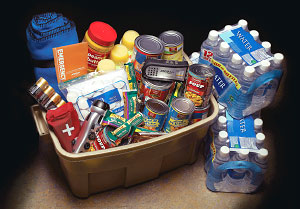The Saturday before Hurricane Sandy struck, I braved the grocery store. I didn’t need storm supplies, but I only have the car once a week and I needed to do my regular shopping. Although I’d expected it to be somewhat busy, even early in the morning, I was surprised by the large number of people in the store and the level of anxiety they were experiencing. The water aisle was empty of supplies. Most necessary storm supplies were gone and it looked like most people had resigned themselves to living on soda pop and cookies for the duration.
I thought gratefully of the water in my basement, of the food that could be eaten without heat, and of the camp stove and fuel ready to be activated until it ran out. I had it only because I’m a Mormon—the popular nickname for members of The Church of Jesus Christ of Latter-day Saints. Since becoming a Mormon at age seventeen, I had been taught again and again to keep a supply of food, water, hygiene items, and other necessary supplies on hand for emergencies. Some people laugh at me when they see me buying large quantities of soup or hygiene supplies. They presume I am preparing for some sort of doomsday scenario, but I’m not. Over the years we have used what we bought, using what is stored and storing what is newly bought, so nothing is wasted. We have relied on it during unemployment, during illnesses that made shopping unpleasant or impossible, and during weather emergencies when the stores were closed or sold out of essentials. It just makes sense to have more food on hand than you plan to eat just this week, since the emergency could strike the day before shopping day.
The next day, as I attended church, we learned that the emergency plan had been activated at the request of the Church. Long before, our congregation had been divided into geographical groups, called blocks. (In the east, where I live, the blocks are really zip codes.) Each “block” had a captain. The captain would call the families in his group that evening to let them know who he or she was and to find out if they had what they needed and if they foresaw any particular problems. For instance, in a previous congregation, when there was a risk of a dam breaking, the block captain noted that I didn’t have a car at home during the day and would need transportation in an evacuation.
Then the captain would contact each person on the list every twelve hours to find out if we had power, water (many are on wells and don’t have water when there is no power), and shelter. If no one answered, someone would come to our home to ensure we weren’t lying sick or injured somewhere, unable to reach a telephone. If we evacuated, we would report in so that someone knew where we were and that we were safe. After the storm, a list of people without power was shared so others could step in to help and those who could stepped in to help with trees and flooded basements.
In many large-scale emergencies, the media has noted the amazing organization of the Mormons. They know where their members are and what the needs are. The Church also steps in to meet local needs of those who are not Mormon. They work with other organizations, such as the Red Cross, and with the local governments, to find out what is required. Often, trucks of supplies are stationed just outside the danger zones in order to get food and water into the impacted areas quickly. After Sandy, the Church answered calls for help from both the Red Cross and Catholic Charities.
After the worst of the danger is past, many Mormons organize themselves as the Mormon Helping Hands, wearing yellow t-shirts or vests, and go into highly impacted neighborhoods. They seek out anyone of any religion who needs help. They clean up after floods, chop fallen trees, and help move items to safety. Our congregation passed around a sign-up sheet for the next seven weekends to volunteer in neighboring New Jersey—a project that would involve camping and supplying all our own food and water, so as not to use already limited local resources, while carrying out heavy physical labor. We learned that other congregations were already spending the weekend at community shelters preparing and serving meals provided by the Church or digging out other areas.
Just before we lost power, the congregation’s Facebook page had cheerful check-ins from members who were playing board games, telling stories, and enjoying treats in cold, dark houses. At least one teenager was volunteering at the Red Cross shelter. We all knew we’d have our hands full in the morning, but for now, we were prepared and ready to accept the storm, however frightening, as an adventure and learning experience that will add to our memories of mortality.
Our family was without power and water for five days. We were checked on continually and offered water, food, and places to stay. However, since we could leave our home after a few days, I wanted to test our supplies and our plan so we were ready for the times we couldn’t get out of the house. (An ice-storm a few years ago left us trapped in our homes for almost a week, but we had running water and telephones in that house.) It is far safer to test your plan when the stakes aren’t high.
We did not run out of food or water, but I did make many changes to my emergency plan based on my experience. Emergency preparedness isn’t something you do once and forget about. It is a constant process of refinement.
By being prepared, we faced the storm and the frustrations of the storm’s inconveniences without fear. It didn’t really matter that many stores near us were closed due to lack of power or that they had limited supplies on hand. We had what we needed and we had a support network if it became necessary. We also had faith and the promise from God that if we are prepared, we have no need to fear. Faith and preparedness—God’s plan for helping us through any trial.
About Terrie Lynn Bittner
The late Terrie Lynn Bittner—beloved wife, mother, grandmother, and friend—was the author of two homeschooling books and numerous articles, including several that appeared in Latter-day Saint magazines. She became a member of the Church at the age of 17 and began sharing her faith online in 1992.





